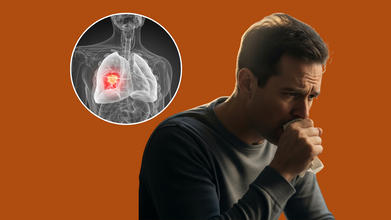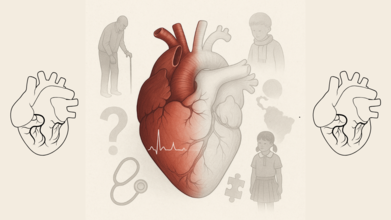Study Links Childhood Trauma To Severe Uterine Disease

(Credit-Canva)
Affecting nearly 190 million menstruating women and girls, endometriosis is a chronic condition that can cause life-impacting pain. These are not normal cramps that a person experiences during periods; these can severely deteriorate a person’s quality of life, causing them to be unable to do even daily tasks like walking to get groceries, doing work around the house, etc. This condition is caused when the uterine lining grows outside the uterus, which then causes severe pain in the pelvis and also causes reproductive issues like infertility. However, what causes endometriosis?
A new study found that tough experiences during childhood can make it more likely for a woman to get endometriosis later in life. Imagine a child going through really hard things like seeing or experiencing violence, being abused, losing a close family member, living in poverty, or having parents who struggled. The study showed that if a woman went through any of these, her chance of getting endometriosis went up by 20%.
Understanding Endometriosis
Endometriosis is a fairly common condition, affecting about 1 out of every 10 women. Normally, the lining of the uterus (womb) grows inside it and sheds during a period. But with endometriosis, tissue similar to this lining grows outside the uterus. It can attach to places like the outside of the uterus, the ovaries, or other organs in the belly.
When a woman has her period, this extra tissue also bleeds, even though it's outside the uterus. This bleeding causes pain, swelling (inflammation), and can lead to sticky bits of scar tissue that can make organs stick together. Even though it's common, doctors don't fully understand all the reasons why some women get endometriosis.
Childhood Trauma and Endometriosis Risk
The study found that women who endured difficult childhood events, such as violence, sexual abuse, the death of a family member, poverty, or having troubled parents, saw their risk of endometriosis increase by 20%. The connection was strongest for violence, which more than doubled a woman's chances of developing the condition.
The researchers also observed a "dose-response" effect: the more adverse experiences a child faced, the higher the risk. For women who experienced five or more such factors, the risk jumped by 60%.
Long-Term Impact
For this study, researchers looked at the health records of over 1.3 million women in Sweden. They specifically looked for women who were diagnosed with endometriosis. Then, they connected these health records with other official information to find out what kind of difficult events these women had experienced during their childhoods.
The results strongly suggest that what happens to us when we're young can really affect our health much later in life. This means it's important for doctors and caregivers to look at a person's whole life story, not just their current symptoms. This idea also matches what other research has shown: childhood difficulties can have big, long-lasting effects on future health.
Possible Explanations
While the study clearly shows a strong connection, it doesn't mean that childhood trauma directly causes endometriosis. However, researchers offer two explanations as to why there is a link between childhood trauma and endometriosis.
Impact on the Immune System
One idea is that a lot of stress during childhood might affect the body's immune system. The immune system is like your body's defense team. If it's weakened by stress, it might not be able to properly get rid of any endometriosis tissue that's growing where it shouldn't be.
Increased Pain Sensitivity
Another idea is that trauma in childhood could change how sensitive a person's body is to pain. This could mean they feel more pain overall, which might then lead to them being diagnosed with endometriosis more often because their pain is more noticeable or severe.
World Lung Cancer Day 2025: Why You Should NOT Ignore A Recurring Cough? Danger Of Overlooking Early Symptoms

Credits: Health and me
Lung cancer remains one of the deadliest forms of cancer worldwide, accounting for nearly one in five cancer-related deaths each year. What makes this cancer especially dangerous is how silently it advances. Many people miss the early signs or ignore them, believing they’re just symptoms of a lingering cold, allergies, or an old infection but on World Lung Cancer Day—observed every year on August 1—the message is clear, early detection can mean the difference between life and death.
First observed in 2012, World Lung Cancer Day was launched by the Forum of International Respiratory Societies (FIRS) in partnership with patient advocacy groups. The aim? To break the silence surrounding lung cancer, correct widespread misconceptions, and push for better early detection and prevention.
Despite advances in medicine, lung cancer continues to slip under the radar. Many associate it solely with smoking, overlooking other contributors like air pollution, genetic factors, or secondhand smoke. Moreover, stigma often deters patients from seeking help early especially non-smokers who don’t consider themselves at risk.
While a chronic cough might seem harmless, dismissing it as seasonal or due to pollution, the reality is that it could be your body’s early warning system. Lung cancer rarely causes symptoms in its earliest stages, which is why seemingly minor signs like a persistent cough or subtle breathlessness deserve closer attention. By the time more severe symptoms—like coughing up blood, wheezing, or unexplained weight loss—appear, the disease may already be in an advanced stage.
What makes lung cancer particularly dangerous is its ability to remain silent until it’s too late. This is why awareness and early screening, especially in high-risk groups, are crucial. Smokers and former smokers, people exposed to secondhand smoke or environmental toxins, and those with a family history should be especially vigilant. Even if you don’t fall into these categories, don’t ignore your instincts. If something feels off—get it checked.
When a Cough Isn't 'Just a Cough'
Dr. Rakesh Pandit, Senior Consultant & Head of Internal Medicine at Aakash Healthcare, emphasizes that we often brush off coughs that last beyond a week or two, that’s a mistake. “A recurring cough is not always just a leftover from the flu or a seasonal allergy,” he says. “It could point to asthma, acid reflux, lung infections, tuberculosis—or even early-stage lung cancer.”
Dr. Pandit adds that if a cough persists for over eight weeks in adults (or four weeks in children), it needs medical attention. And it’s not just about coughs—symptoms like breathlessness, chest pain, coughing up blood, wheezing, or unexplained weight loss should be immediate red flags.
In fact, lung cancer is often detected late because the symptoms can be vague or mimic other conditions, a long-standing cough, shortness of breath, and fatigue—these aren’t always alarming on their own, but together, they can signal something serious.
Technological advances in low-dose CT scans now allow for earlier detection, improving survival rates significantly. The five-year survival rate for early-stage lung cancer can be as high as 60%, compared to just 6% in advanced stages. That’s a major difference—and it all starts with paying attention to symptoms that seem small.
Also, it’s not just about cancer. Chronic coughing and breathlessness can be early signs of other serious conditions like COPD, pulmonary fibrosis, or even heart failure. So addressing them isn’t just about cancer prevention—it’s about taking charge of your overall respiratory health.
What Missed Symptoms Can Lead To?
Dr. Sachin Kumar, Director of Pulmonology & Critical Care Medicine at Sakra World Hospital in Bengaluru, recalls a case that perfectly illustrates the cost of late detection. A 48-year-old man visited a doctor for back pain. Painkillers didn’t work. An MRI revealed cancer in the spine—further tests showed the primary cancer was in the lungs. It had already spread.
“This is how deceptive lung cancer can be,” Dr. Kumar explains. “Often, the first symptoms don’t even involve the lungs. That’s why awareness is key.”
Why Lung Cancer Is Not Just a Smoker’s Disease?
One of the most dangerous myths about lung cancer is that only smokers are at risk. While smoking remains the number one cause, non-smokers aren’t safe either. Dr. Debanti Banerjee, Consultant at HCG Cancer Center, Kolkata, warns that more young adults, women, and non-smokers are being diagnosed than ever before.
“Increasingly, we’re seeing lung cancer in non-smokers—possibly due to genetic predispositions, air pollution, and environmental toxins,” she explains. “People must understand that anyone can get lung cancer, and everyone needs to be vigilant about symptoms.”
She adds, “Lung cancer doesn’t always shout—it often whispers. Catching it in stage 1 or 2 can mean curative treatment. Catching it at stage 3 or 4? That’s a different story.”
What Are The Environmental Triggers and Everyday Risks?
In addition to smoking and secondhand smoke, prolonged exposure to pollution, dust, biomass fuel (like wood or coal used for cooking), and occupational hazards (like asbestos) significantly increase lung cancer risk. People living or working in such conditions often develop chronic coughs from continuous lung irritation. Unfortunately, this persistent irritation can mask the early signs of something more dangerous.
“Especially in urban environments, we’re breathing in harmful particles every day,” Dr. Pandit says. “If you’re in a high-risk environment, you can’t afford to ignore a chronic cough or delay a check-up.”
What You Can Do To Prevent And Early Diagnosis?
Here’s the thing—lung cancer caught early is often treatable but because early symptoms are vague, diagnosis is frequently delayed. The solution lies in being proactive.
- Don’t dismiss persistent symptoms, especially coughs, breathlessness, fatigue, or weight loss.
- Get screened if you’re high-risk, this includes smokers, ex-smokers, people over 50, or those with a family history.
- Avoid triggers, stay away from secondhand smoke, reduce exposure to pollution, and use protective gear if working in hazardous conditions.
- Vaccinate for infections like tuberculosis and influenza can damage lungs and increase vulnerability.
- Annual health checks should be part of your routine, not just something you do when you’re sick.
“Most causes of a recurring cough are treatable if caught early,” Dr. Pandit says. “That’s why a cough that won’t quit needs more than just home remedies or over-the-counter syrup. It needs medical evaluation.”
When detected in its early stages, non-small cell lung cancer (NSCLC)—the more common and slower-growing form—can often be removed surgically or treated with radiation and targeted therapies. But in later stages, treatment gets more complicated and outcomes become uncertain.
Dr. Banerjee sums it up best, “We need to move beyond fear and stigma. Early diagnosis isn’t about being alarmist—it’s about giving people a fighting chance.”
The theme of World Lung Cancer Day isn’t just about awareness. It’s a call to action- to listen to your body, to challenge the assumptions around who gets lung cancer and to make preventive health a priority. So, if you or someone you know has a cough that keeps coming back, don’t wait.
4 Rare Heart Diseases That Are Becoming Common By Each Passing Day

Credits: Canva and AI generated
Heart disease is often associated with common conditions like heart attacks or cardiac arrest. But beyond these lies a group of lesser-known, often overlooked cardiovascular disorders that are gradually becoming more prevalent, or at least more recognized, as awareness grows.
Collectively, rare cardiovascular diseases affect nearly 5% of the global population. While each condition individually may be considered rare, their collective impact is significant, especially given the diagnostic challenges and the toll they take on patients and caregivers alike.
According to Dr. Sanjay Bhat, Sr. Consultant, Interventional Cardiology at Aster CMI Hospital, Bangalore, many of these diseases mimic more common heart issues, which leads to frequent misdiagnosis or delayed treatment.
Here's a closer look at four such conditions that deserve urgent attention.
Transthyretin Amyloid Cardiomyopathy (ATTR-CM)
ATTR-CM is a form of cardiac amyloidosis, a rare but fatal condition marked by the buildup of abnormal proteins in the heart. This leads to stiffening of the heart muscle and progressive heart failure. As per the World Heart Federation, it typically affects men over the age of 60, though women can also be diagnosed.
Unlike a typical heart attack, caused by blocked arteries, ATTR-CM often shows no such obstructions. “In elderly patients with unexplained fatigue or breathlessness, especially when routine tests show thickened heart walls or declining function without clear cause, ATTR-CM should be considered,” says Dr. Bhat.
Diagnosis involves specialized imaging, blood tests, and occasionally bone scans—no biopsy required. Unfortunately, many patients are initially misdiagnosed with standard heart failure or dismissed as simply aging.
Kawasaki Disease
Once considered exceedingly rare, Kawasaki Disease is now recognized as a leading cause of acquired heart disease in children, notes the World Heart Federation. It causes inflammation in blood vessels, especially the coronary arteries, which can result in aneurysms or long-term narrowing.
Unlike adult heart attacks, which stem from plaque buildup, Kawasaki disease involves inflammation. “Because children don’t exhibit the same symptoms as adults—such as chest pain—early diagnosis can be tricky,” Dr. Bhat explains. Timely treatment, often with immunoglobulins and aspirin, is crucial. Regular follow-ups are essential to monitor for any delayed cardiac complications.
Chagas Disease
Chagas disease is a parasitic infection caused by Trypanosoma cruzi, and is most common in Latin America, although migration has spread it to other regions. It remains underdiagnosed and misunderstood.
“Chagas can damage the heart muscle over time, eventually leading to arrhythmias, heart failure, or sudden cardiac death,” notes Dr. Bhat.
Because symptoms like fatigue, palpitations, or gastrointestinal discomfort can mimic other conditions—or even be brushed off as stress, it often goes undetected for years, especially in immigrant populations unfamiliar to local healthcare providers.
Misdiagnoses are common, ranging from anxiety to chronic fatigue syndrome.
Rheumatic Heart Disease (RHD)
Still prevalent in many low-and middle-income countries, Rheumatic Heart Disease stems from untreated streptococcal throat infections in childhood. The resulting immune response can cause permanent damage to the heart valves. The World Heart Federation notes that this affects 39 million people worldwide.
“Unlike a heart attack, which is sudden, RHD progresses over years, quietly damaging the valves until symptoms like breathlessness or swelling become obvious,” says Dr. Bhat.
This slow progression often means the disease isn’t detected until advanced stages, particularly affecting young adults and women during pregnancy.
Bridging the Diagnosis Gap
Many rare heart conditions present with overlapping symptoms: fatigue, breathlessness, swelling—which makes early diagnosis a challenge.
“It’s vital for general practitioners and cardiologists to collaborate closely,” Dr. Bhat advises. “When conventional treatments fail or symptoms don’t align with typical diagnoses, we must look deeper. Family history, ethnic background, and country of origin can offer vital clues.”
Advanced imaging tools like cardiac MRI, bone scans, and genetic screening are becoming essential in identifying these rare diseases. But at the heart of the solution is increased awareness, both among healthcare providers and the public. Because in the end, every heartbeat truly does matter.
NHS Prompts People To Watch Out For This Summer Skin Sign - 'Call Emergency Services Immediately'

(Credit-Canva)
As UK temperatures rise, more and more people are concerned about heat related illnesses and how to ensure they stay safe in this weather. In fact, in June of 2025, the UK National Health Service website had 31,524 visits within 48 hours as they issued a heat-health alert, compared to the 10,000 views they had just days prior. This helped many people be aware of their health and keep safe. However, temperatures are yet to relent, and One must stay careful.
With the UK currently experiencing very high temperatures, it's really important to know the signs of heatstroke, which can be quite dangerous. The NHS is telling people to dial 999 right away if they see a particular, serious symptom on someone's skin. This is a crucial step because heatstroke can be life-threatening if not addressed quickly.
Heatstroke: An Emergency Situation
Heat exhaustion is a milder condition, but it can quickly get much worse and turn into heatstroke if it's not dealt with fast. The NHS explains that if someone has heat exhaustion, they usually won't need emergency medical help as long as they can cool down within about half an hour. However, if that heat exhaustion turns into heatstroke, it's a completely different story – it becomes a real emergency. The health service is very clear: you should "call 999 now if you or someone else has signs of heatstroke." This isn't a suggestion; it's a direct instruction for a serious situation.
Key Heatstroke Symptoms to Watch For
One very important sign to look out for is skin that feels hot to the touch but isn't sweating, and it might look red. It's worth noting that this particular sign can be harder to spot on darker skin tones.
You also need to get emergency help if someone still isn't feeling well after being in a cool place for 30 minutes, having cooling treatments applied, and drinking fluids. Other signs of heatstroke that mean you should call 999 immediately include: an extremely high body temperature; a very fast pulse or heartbeat; breathing that is quick or difficult; feeling confused and having trouble moving in a coordinated way; having a seizure or fit; or passing out (losing consciousness).
If the person becomes unconscious while you're waiting for help to arrive, the NHS advises you to gently roll them onto their side into the recovery position.
Warning Signs of Heat Exhaustion
Before someone gets to the serious stage of heatstroke, there are earlier warning signs of heat exhaustion. Keep an eye out for these:
- Feeling very, very tired.
- Feeling dizzy.
- Having a headache.
- Feeling sick to your stomach or actually vomiting.
- Cramps in your arms, legs, and stomach.
- Sweating a lot, and your skin might look pale and feel clammy, or you might even get a heat rash.
- Your breathing or heartbeat might be fast.
- You'll likely have a high temperature.
- Feeling extremely thirsty.
- Feeling weak.
The NHS points out that these symptoms are generally the same for both adults and children, though children might also become irritable or cranky.
What to Do if Someone Has Symptoms
If you notice someone showing these signs of heat exhaustion, the most important thing is to cool them down right away and get them to drink fluids. The NHS recommends these four essential steps:
- Move them to a cool, shady spot. Get them out of the heat!
- Take off any extra clothing they don't need, like a jacket or thick socks.
- Encourage them to drink a sports drink, a rehydration drink, or just cool water. These drinks help replace lost salts and fluids.
Stay with the person until they start to recover, which should happen within about 30 minutes. However, if they don't get better after following these steps, you might need to call 999 for emergency help.
© 2024 Bennett, Coleman & Company Limited

